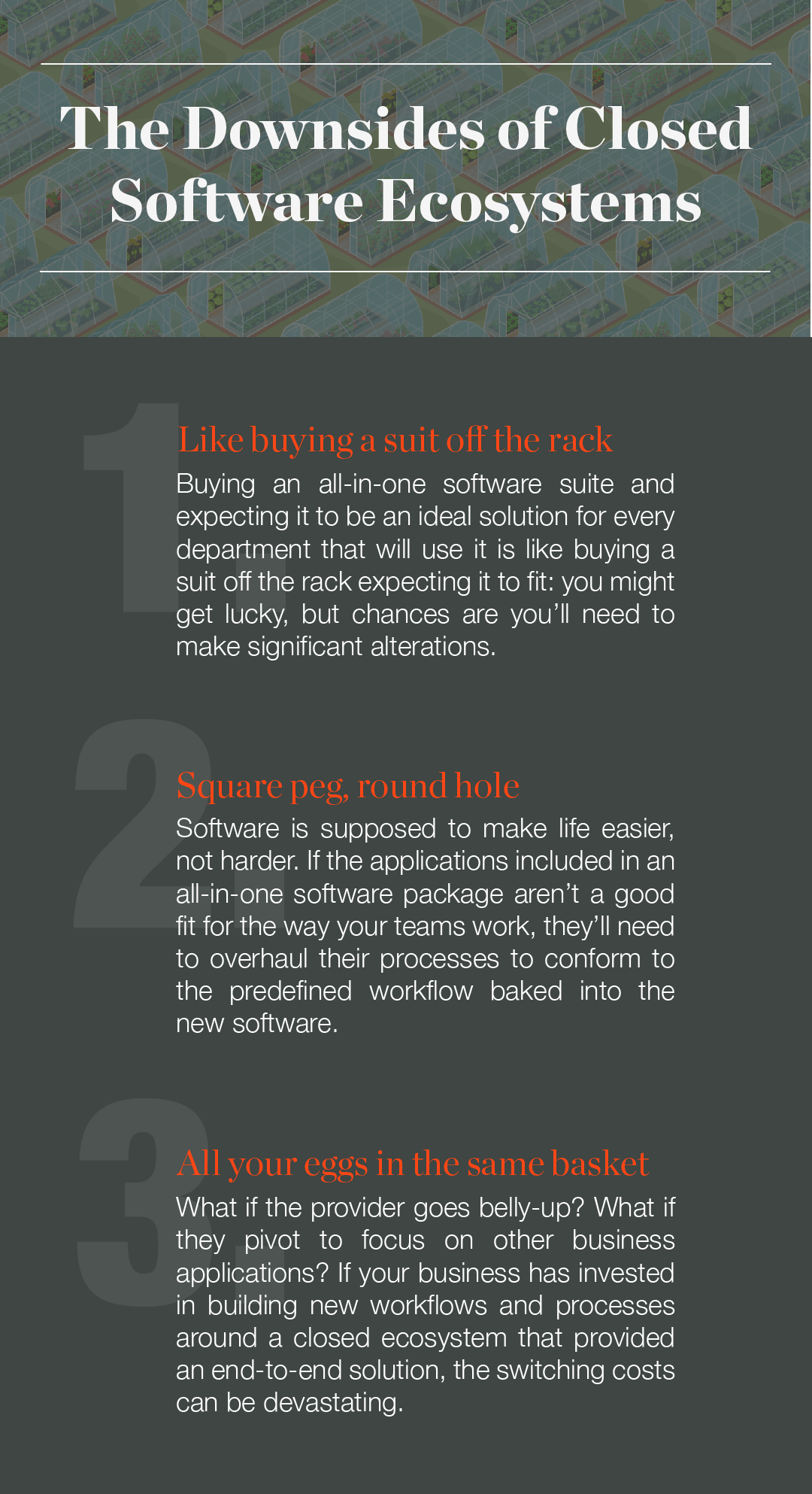With the relatively recent explosion of industry-specific software solutions for commercial real estate companies, the task of comparing and evaluating various software platforms is becoming increasingly difficult. If you’ve spent any time researching CRE software, you’ve no-doubt come across the “open ecosystem” buzzword. But what does “open ecosystem” mean, exactly? And why should you care? Read on.
Ecosystems and Integrations
In biology, the term “ecosystem” describes the complex interactions and mutual dependencies between organisms that, collectively, enable the system to function. In software, the idea is more or less the same: the “ecosystem” label necessarily implies that individual software applications are interconnected in some way.
Your smartphone is an excellent example of a software ecosystem on a small scale: your Contacts app is connected to your Mail app, which is connected to your Calendar app, which is connected to your Reminders app, which is connected to your Maps app, and so on. Sure, all of these applications can work independently from one another, but they work so much more efficiently when they’re connected, communicating, and reacting to changes within the ecosystem.
There are two primary approaches to creating software ecosystems: an ‘open’ approach and a ‘closed’ approach. A comparison between Apple’s iOS and Google’s Android offers a relatively clear (if imperfect) illustration of open vs. closed ecosystems. Apple’s iPhone/iOS platform is generally classified as a closed ecosystem because Apple has complete control over both the software (the operating system and apps that can be installed) and the hardware (the phone itself). In contrast, the Android operating system is freely available to anyone, can run on just about any mobile hardware, and has no restrictions on the applications the user can install.
Neither approach is the “correct” one. Both options have unique advantages and disadvantages and excel at different things. Ultimately, making a choice between the platforms comes down to assessing which option is a better fit for your needs. The important takeaway here is that, in either case, applications exist within a larger ecosystem and are interconnected.
Software Ecosystems in CRE: Open vs. Closed
With that explanation out of the way, let’s get to the important stuff: Why does this matter for CRE? Because much like the consumer software ecosystem, the options available to enterprise fall into similar “open” or “closed” categories. Most software solutions that embrace the open ecosystem approach are built to address a specific, specialized need; usually at the department level.
In contrast, closed-ecosystem options, because of their proprietary nature, are generally designed as a “suite” of different applications all under the same umbrella and developed by the same company. The software applications in a closed system are designed to communicate, but typically cannot communicate with other applications outside the system.
We won’t dance around the question and pretend to be neutral: open ecosystems are the way to go for most enterprise applications. Closed ecosystems, while great for the consumer market where convenience and ease-of-use are often the top concerns, have three primary downsides in the enterprise market, explained in the accompanying graphic.
By choosing to use software that embraces an open ecosystem, these issues are minimized or eliminated entirely. You’re able to choose application-specific, à la carte software that meets the specific needs of each department. And in the future, if one software application needs to change, it won’t significantly disrupt the operations of other departments. If the brokers need to change their CRM software, the accountants don’t need to change their accounting software.
A Tangible Example
To put it in more tangible terms, let’s look at how a hypothetical CRE company, Prestige Worldwide, can choose different software providers without sacrificing the ability for one platform to talk to another.
Prestige uses VTS to manage its sales process, LeasePilot to manage lease negotiation, and MRI to handle property management and accounting. Each of these software solutions delivers significant value on its own, but if none of these platforms embraced the open ecosystem, there’d be a major inefficiency: at each step in the leasing lifecycle, key data would need to be manually migrated from one platform to the other. Thankfully for Prestige Worldwide, VTS, LeasePilot, and MRI have all embraced the open ecosystem.
Data collected and stored in VTS during the sales process gets automatically passed over to LeasePilot after the LOI is signed, and the first draft of the leaser is pre-populated with all the relevant information that was collected during the sales process. After the tenant signs, data is passed over to MRI for continued management of the lease.
The value proposition that this kind of data continuity provides is twofold. First, it eliminates the time-consuming, tedious process of manual data entry. Second, and perhaps most importantly, it completely eliminates the inherent risk of manual data entry errors. If VTS, LeasePilot, and MRI are the meat and potatoes of your workflow, data integration between platforms is the secret sauce that separates you from the rest of the pack.
